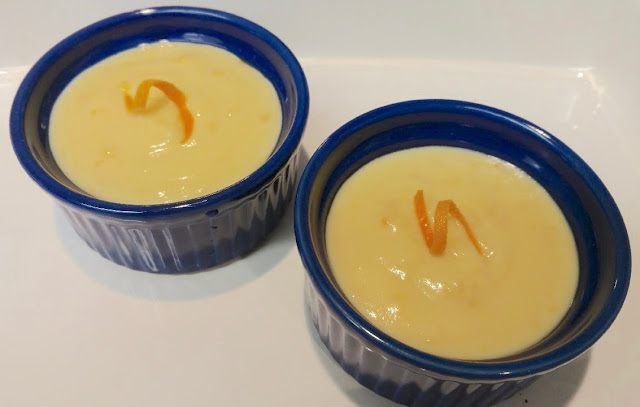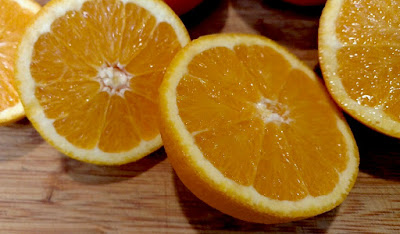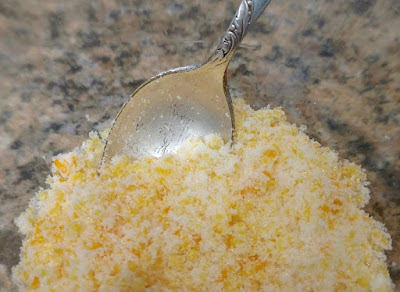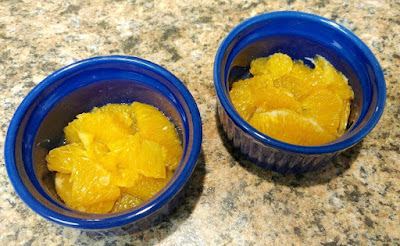
Recipe: Fresh orange custard boasts old-fashioned flavors

(Photos: Debbie Arrington) |

|
If you like the flavor of fresh oranges, this old-fashioned custard is for you.
I love fresh oranges, which is a good thing: We have backyard citrus trees and a steady supply of sweet winter fruit.
In search of more ways to enjoy oranges, I recalled that my grandmother occasionally made an orange pudding that could double as a pie filling; it wasn’t chiffon, it was custard.
While that specific recipe still eludes me, this one comes close. The orange segments (an idea borrowed from “Joy of Cooking”) give it a fresh taste, added texture and a lot more orange flavor. The fruit is like buried treasure hidden under the rich topping.
Take some extra time to “supreme” the orange segments. Remove all the fibrous membranes by slicing the fruit sections out instead of pulling the sections apart. The trick is to use a sharp knife and cut along each membrane where it meets the juice sacs. Forming a wedge, cut along one membrane; do the same on the other side of that segment. Then, pop the segment out. It’s handy to work over a bowl to catch the segments and juice. Or you can use a cutting board to steady the fruit.
The orange supremes look pretty at the bottom of a glass bowl topped by the silky custard speckled with orange zest.

|
Fresh orange custard
Makes 4 servings
Ingredients:
2 tablespoons orange zest
1/3 cup sugar
4 oranges
2 cups low-fat milk
¼ cup heavy cream
3 egg yolks
2 tablespoons cornstarch
1/2 teaspoon vanilla extract
Instructions:

The drained orange sections are spooned into the bottom
of the ramekins (or bowl).
|
Mix together orange zest and sugar. Set aside.
Over a large bowl, peel oranges with a sharp knife, cutting away the white pith and letting any juice collect in the bowl. Section the oranges supreme-style, slicing along the membranes; remove any seeds. Put the orange sections in the bowl and squeeze any remaining juice from the membranes over the sections. Set aside.
In a saucepan over medium heat, mix together milk and cream. Scald the milk (heating until little bubbles form around the edges), stirring often so it doesn’t stick.
Meanwhile, in the top of a double boiler, beat the egg yolks. Stir in the hot scalded milk.
Add cornstarch to the zest-sugar mixture; stir into custard. Stir in vanilla extract.
In the double boiler over medium heat, cook the custard until thickened, stirring often (it takes about 7 minutes). Remove from heat and let cool a few minutes.

Place spoonfuls of orange segments at the bottom of a glass dish or into individual ramekins. Spoon custard over the orange segments. Chill.
Comments
0 comments have been posted.Sacramento Digs Gardening to your inbox.
Sites We Like
Garden Checklist for week of May 5
Survey your garden after the May 4 rainstorm. Heavy rain and gusty winds can break the neck of large flowers such as roses. Also:
* Keep an eye on new transplants or seedlings; they could take a pounding from the rain.
* Watch out for powdery mildew. Warmth following moist conditions can cause this fungal disease to “bloom,” too. If you see a leaf that looks like it’s dusted with powdered sugar, snip it off.
* After the storm, start setting out tomato transplants, but wait on the peppers and eggplants (they want warmer nights). Pinch off any flowers on new transplants to make them concentrate on establishing roots instead of setting premature fruit.
* Trim dead flowers but not leaves from spring-flowering bulbs such as daffodils and tulips. Those leaves gather energy to create next year's flowers. Also, give the bulbs a fertilizer boost after bloom.
* Pinch chrysanthemums back to 12 inches for fall flowers. Cut old stems to the ground.
* Mulch around plants to conserve moisture and control weeds.
* From seed, plant beans, beets, cantaloupes, carrots, corn, cucumbers, melons, pumpkins, radishes and squash.
* Plant onion sets.
* In the flower garden, plant seeds for asters, cosmos, celosia, marigolds, salvia, sunflowers and zinnias. Transplant petunias, zinnias, geraniums and other summer bloomers.
* Plant perennials and dahlia tubers for summer bloom.
* Don’t wait; plant summer bulbs, such as gladiolus and tuberous begonias.
* Harvest cabbage, lettuce, peas and green onions.